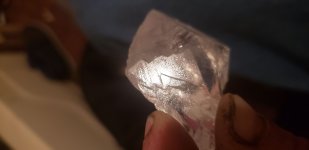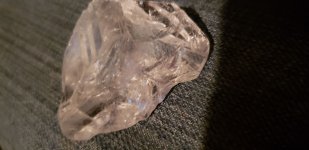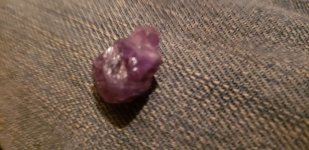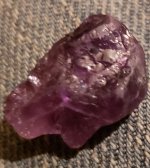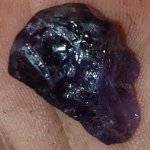Navigation
Install the app
How to install the app on iOS
Follow along with the video below to see how to install our site as a web app on your home screen.
Note: This feature may not be available in some browsers.
More options
You are using an out of date browser. It may not display this or other websites correctly.
You should upgrade or use an alternative browser.
You should upgrade or use an alternative browser.
What would you call this?
- Thread starter Caleb12
- Start date
Indian Steve
Silver Member
You told us before that you diamond tester didn't work on raw diamonds, now it didn't come. Seems like you have a problem with the TRUTH.
Upvote
0
- Dec 12, 2009
- 2,817
- 3,356
- Detector(s) used
- Garrett AT Pro, Tesoro Vaquero, Bounty Hunter Land Star, Teknetics Delta 4000, Minelab Equinox 600, Garrett Carrot
- Primary Interest:
- All Treasure Hunting
Nice quartz!
Upvote
0
- Jul 27, 2006
- 49,451
- 57,760
- Detector(s) used
- Minelab_Equinox_ 800 Minelab_CTX-3030 Minelab_Excal_1000 Minelab_Sovereign_GT Minelab_Safari Minelab_ETrac Whites_Beach_Hunter_ID Fisher_1235_X
- Primary Interest:
- All Treasure Hunting
Diamond testors do work on raw diamonds.
Diamonds over 8 mm, in excess of 2 grams in weight are extremely rare. The chances of finding a diamond are 1 in 10,000,000. The chances of finding a diamond over 8 mm, in excess of 2 grams in weight are 1 in 1,000,000,000. That is one chance in a billion!
OK, so you think you beat the odds and actually found a rough diamond. Now how do you test it to confirm it is a diamond?
Crystal Form:
Looking at the crystal form is a quick way of differentiating diamond from most of the other minerals that look like diamond.
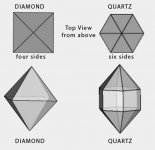
Diamonds are cubic (isometric) form. The most common mineral that looks like a diamond is quartz and it is hexagonal form. When looking down on the crystals from the top, with the point of the crystal aimed at your eye, quartz will have six sides and a diamond will have four sides. If you see six sides than you probably found quartz.
Fracture:
When diamonds break, they will cleave creating smooth, flat surfaces. Quartz and glass will create conchoidal surfaces when they break.
If you see curved conchoidal surfaces (see photo above) then you know your sample is not a diamond.
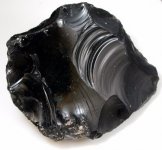
Test Hardness:
You CANNOT test the suspect diamond by scratching glass.
Many minerals scratch glass. Glass is 5.5 on the Moh's Scale of Hardness. The following list is of common minerals that scratch glass, may look like diamond and they are much more common the diamonds:
Albite
Beryllonite
Boracite
Corundum
Danburite
Elbaite
Euclase
Grossular
Marialite
Oligoclase
Orthoclase
Petalite
Phenakite
Pollucite
Quartz
Sanidine
Sillimanite
Spodumene
Topaz
Zircon
Zoisite
So do not try scratching glass with the suspected diamond. The only hardness test that will identify a diamond is scratching corundum. Corundum, which includes all rubys and sapphires, is 9 on the hardiness scale. If your suspected diamond crystal can scratch corundum, then there is a good chance that you found a diamond. But NO OTHER HARDNESS TEST will identify a diamond.
Click here to buy inexpensive corundum crystals for testing diamond hardness.
Test Specific Gravity:
Testing for specific gravity will determine the density of a diamond. Actual diamond has a density of 3.5 - 3.53 g/cm3 and you can use this easy home test for specific gravity at: Simple Specific Gravity Test at Home.
But this test is difficult to perform accurately on small samples. If your sample is large, then you failed the question 1 in the first section. If your sample is small, then the accuracy is poor. So unless you have access to a laboratory scale then I suggest skipping the specific gravity test.
Test for Thermal Absorption:
Diamonds absorb heat better than any other mineral and there are a wide variety of portable diamond testers on the market. Search on Google for "Portable Diamond Tester" and you will find many for sale from $13 to $300. Do NOT buy a cheap tester -- they are made in China and are not very accurate. You should spend around $150 for a good tester.
These diamond testers are hand-held devices with a metal probe that is held in contact with the suspected diamond. It generates a small amount of heat and measures the speed that the heat is absorbed by the crystal. Good testers can differentiate between diamond, moissanite (a common synthetic diamond-simulant), and other minerals.
You do not have to buy a diamond tester. Almost any reputable jeweler will own one, and testing is quick and easy. So try visiting your local jeweler and ask if he will test your suspected diamond.
Conclusion
The odds are against you finding a diamond. But if you are not convinced, first look at the crystal shape to see if it is isometric form, make sure the fracture surfaces are not conchoidal, check if it scratches a corundum crystal. If it passes all of the above, then try a diamond tester to measure thermal absorption.
One final thought...
The odds of finding a diamond are equal to being struck by lightning on your birthday 20 years in a row. Even if you found a real diamond, purchased a diamond tester to verify, nobody will take you seriously. The ONLY way you will convince anybody it is a real diamond is to have it certified by the Gemmological Institute of America (GIA). For a fee they will test your "diamond" and give you a certificate absolutely, positively identifying it as diamond, plus they will give you back the diamond unharmed. With that certificate you will have proof of your find, and buyers will be seriously interested in purchasing your find.
Because a GIA certificate will eventually be required anyway, save your money and do NOT buy a diamond tester. Instead send it straight to the GIA for a certification.
http://www.johnbetts-fineminerals.com/jhbnyc/diamondtest.htm
Diamonds over 8 mm, in excess of 2 grams in weight are extremely rare. The chances of finding a diamond are 1 in 10,000,000. The chances of finding a diamond over 8 mm, in excess of 2 grams in weight are 1 in 1,000,000,000. That is one chance in a billion!
OK, so you think you beat the odds and actually found a rough diamond. Now how do you test it to confirm it is a diamond?
Crystal Form:
Looking at the crystal form is a quick way of differentiating diamond from most of the other minerals that look like diamond.

Diamonds are cubic (isometric) form. The most common mineral that looks like a diamond is quartz and it is hexagonal form. When looking down on the crystals from the top, with the point of the crystal aimed at your eye, quartz will have six sides and a diamond will have four sides. If you see six sides than you probably found quartz.
Fracture:
When diamonds break, they will cleave creating smooth, flat surfaces. Quartz and glass will create conchoidal surfaces when they break.
If you see curved conchoidal surfaces (see photo above) then you know your sample is not a diamond.

Test Hardness:
You CANNOT test the suspect diamond by scratching glass.
Many minerals scratch glass. Glass is 5.5 on the Moh's Scale of Hardness. The following list is of common minerals that scratch glass, may look like diamond and they are much more common the diamonds:
Albite
Beryllonite
Boracite
Corundum
Danburite
Elbaite
Euclase
Grossular
Marialite
Oligoclase
Orthoclase
Petalite
Phenakite
Pollucite
Quartz
Sanidine
Sillimanite
Spodumene
Topaz
Zircon
Zoisite
So do not try scratching glass with the suspected diamond. The only hardness test that will identify a diamond is scratching corundum. Corundum, which includes all rubys and sapphires, is 9 on the hardiness scale. If your suspected diamond crystal can scratch corundum, then there is a good chance that you found a diamond. But NO OTHER HARDNESS TEST will identify a diamond.
Click here to buy inexpensive corundum crystals for testing diamond hardness.
Test Specific Gravity:
Testing for specific gravity will determine the density of a diamond. Actual diamond has a density of 3.5 - 3.53 g/cm3 and you can use this easy home test for specific gravity at: Simple Specific Gravity Test at Home.
But this test is difficult to perform accurately on small samples. If your sample is large, then you failed the question 1 in the first section. If your sample is small, then the accuracy is poor. So unless you have access to a laboratory scale then I suggest skipping the specific gravity test.
Test for Thermal Absorption:
Diamonds absorb heat better than any other mineral and there are a wide variety of portable diamond testers on the market. Search on Google for "Portable Diamond Tester" and you will find many for sale from $13 to $300. Do NOT buy a cheap tester -- they are made in China and are not very accurate. You should spend around $150 for a good tester.
These diamond testers are hand-held devices with a metal probe that is held in contact with the suspected diamond. It generates a small amount of heat and measures the speed that the heat is absorbed by the crystal. Good testers can differentiate between diamond, moissanite (a common synthetic diamond-simulant), and other minerals.
You do not have to buy a diamond tester. Almost any reputable jeweler will own one, and testing is quick and easy. So try visiting your local jeweler and ask if he will test your suspected diamond.
Conclusion
The odds are against you finding a diamond. But if you are not convinced, first look at the crystal shape to see if it is isometric form, make sure the fracture surfaces are not conchoidal, check if it scratches a corundum crystal. If it passes all of the above, then try a diamond tester to measure thermal absorption.
One final thought...
The odds of finding a diamond are equal to being struck by lightning on your birthday 20 years in a row. Even if you found a real diamond, purchased a diamond tester to verify, nobody will take you seriously. The ONLY way you will convince anybody it is a real diamond is to have it certified by the Gemmological Institute of America (GIA). For a fee they will test your "diamond" and give you a certificate absolutely, positively identifying it as diamond, plus they will give you back the diamond unharmed. With that certificate you will have proof of your find, and buyers will be seriously interested in purchasing your find.
Because a GIA certificate will eventually be required anyway, save your money and do NOT buy a diamond tester. Instead send it straight to the GIA for a certification.
http://www.johnbetts-fineminerals.com/jhbnyc/diamondtest.htm
Last edited:
Upvote
0
I see a well focused fabric with a poorly focused purple object on it that may be a rock. The quality of the image is so poor that my trifocal assisted eyes will not offer an opinion.
On Copenhagen time for a few weeks, so coffee time is all screwed up.
On Copenhagen time for a few weeks, so coffee time is all screwed up.
Last edited:
Upvote
0
- Jul 27, 2006
- 49,451
- 57,760
- Detector(s) used
- Minelab_Equinox_ 800 Minelab_CTX-3030 Minelab_Excal_1000 Minelab_Sovereign_GT Minelab_Safari Minelab_ETrac Whites_Beach_Hunter_ID Fisher_1235_X
- Primary Interest:
- All Treasure Hunting
View attachment 1631610what about this one?
Test it with the diamond tester you told us you bought, a diamond tester will tell you if it is a raw diamond and YES diamond testers do work on raw diamonds.
Upvote
0
Top Member Reactions
-
 3334
3334 -
 1928
1928 -
 1922
1922 -
 1192
1192 -
 1094
1094 -
 865
865 -
 821
821 -
 818
818 -
 814
814 -
 787
787 -
 777
777 -
 533
533 -
 501
501 -
 477
477 -
 425
425 -
E
419
-
 418
418 -
 418
418 -
 395
395 -
 387
387
Users who are viewing this thread
Total: 2 (members: 0, guests: 2)
